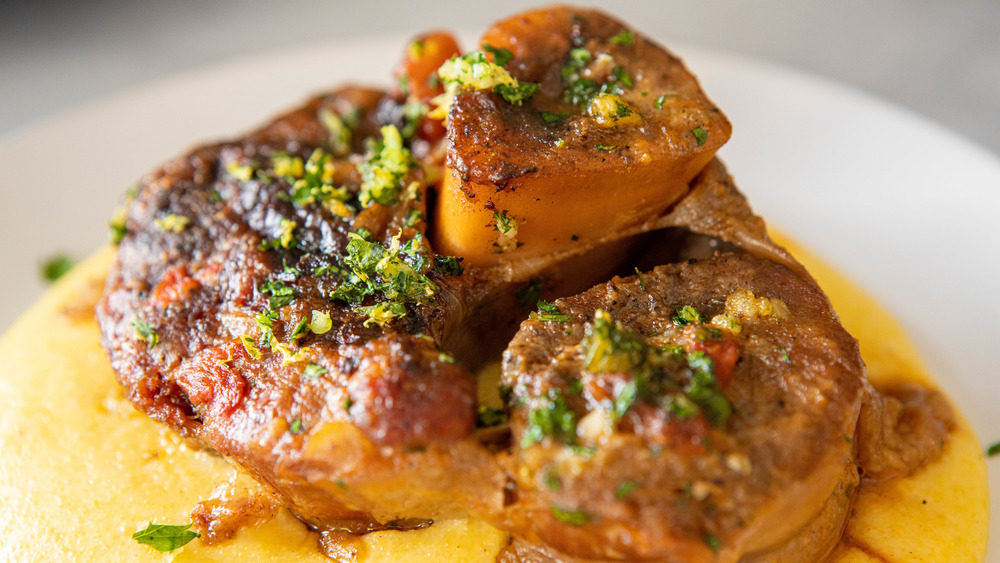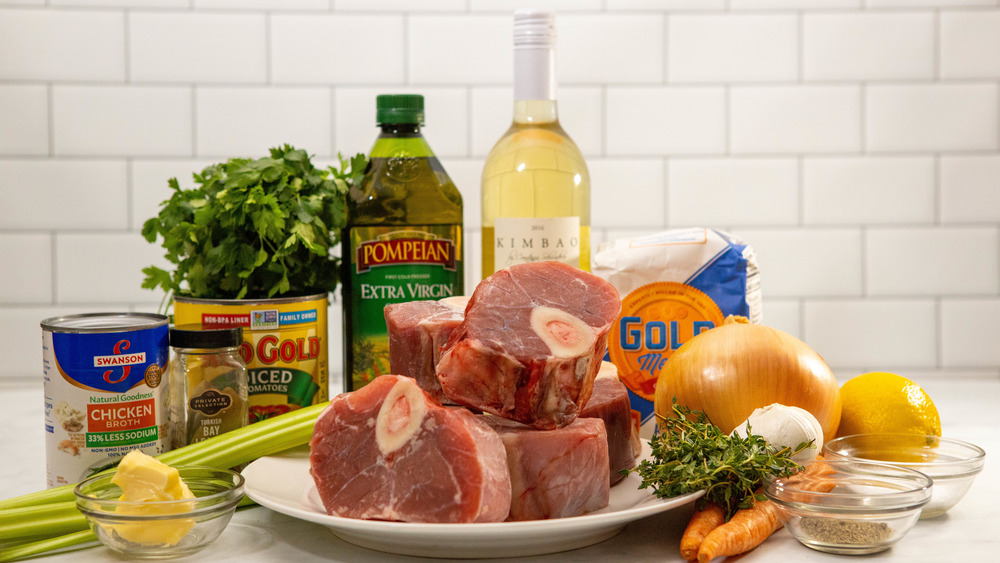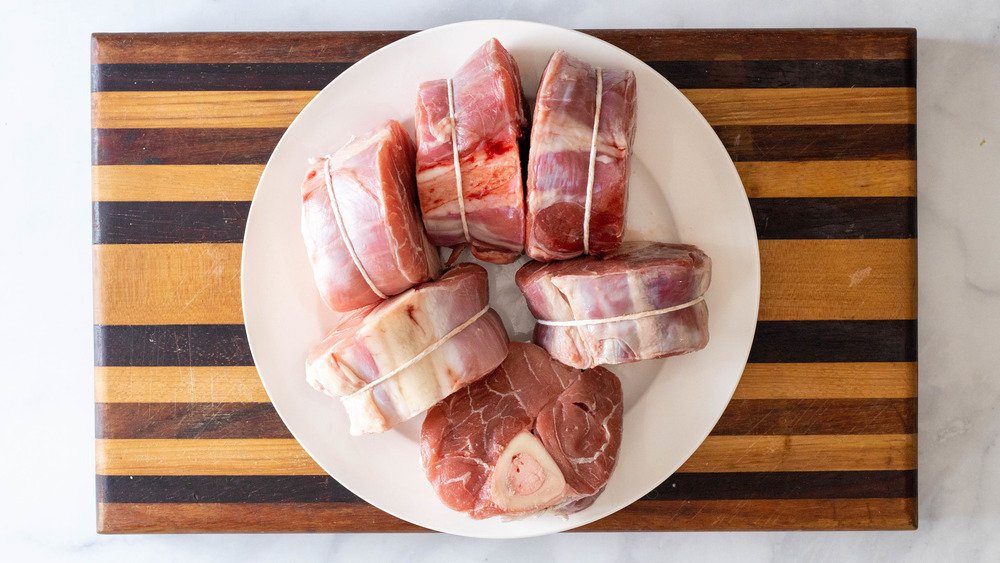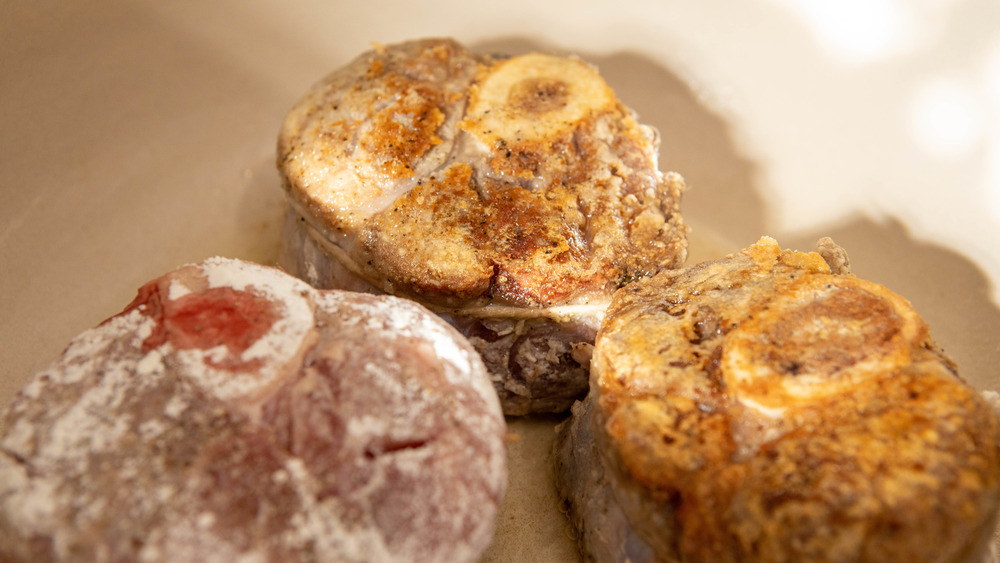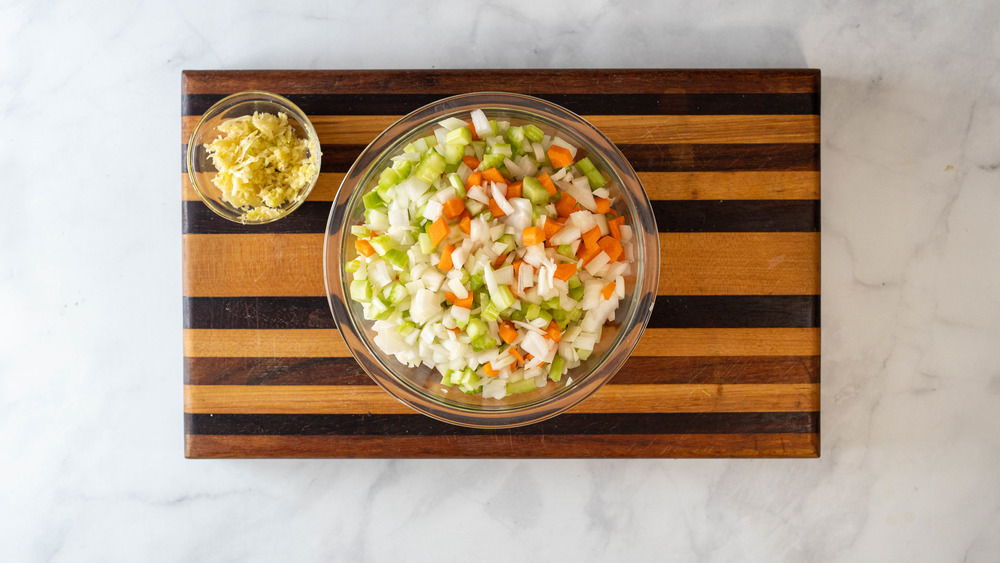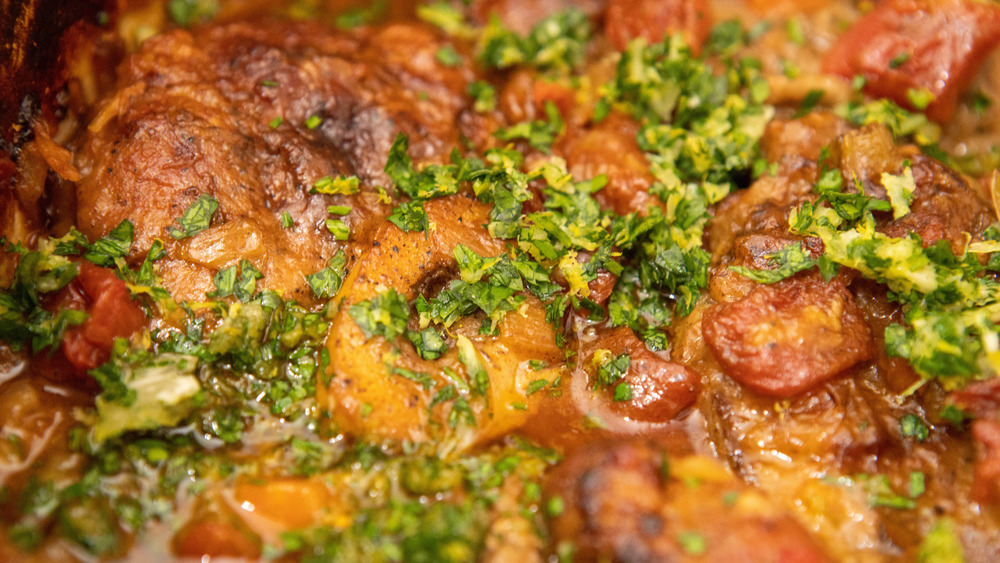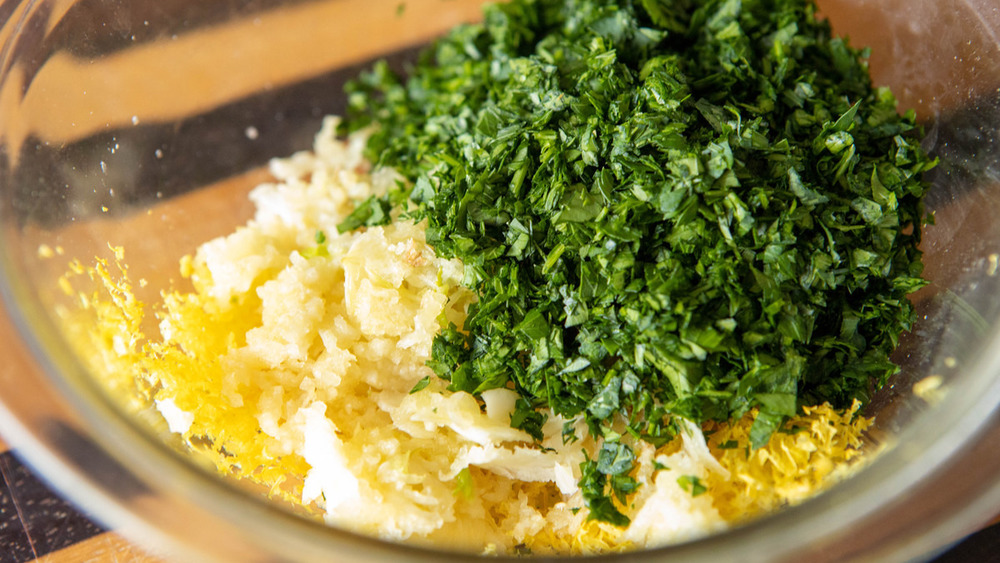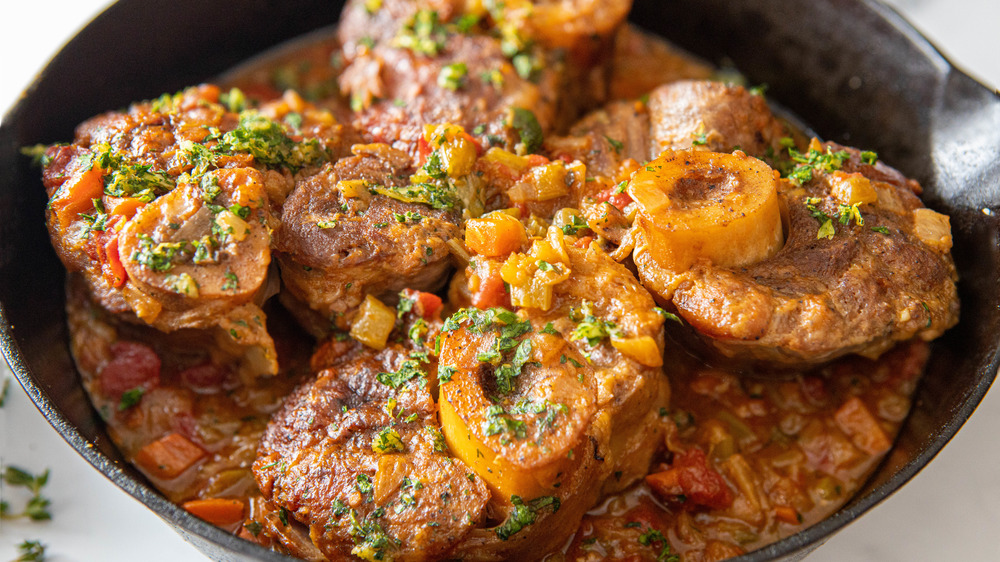Homemade Ossobuco Recipe
Ossobuco is one of those wonderful Italian dishes that you probably never thought you could make yourself. Food photographer and recipe developer Keith Kamikawa has created an ossobuco recipe that any cook at any expertise level can do in the comfort of their own home. Kamikawa's recipe isn't difficult, but since it's a braise that will take a while to cook, his ossobuco is ideal for a laid-back weekend afternoon. If you're wondering what ossobuco means, it translates from Italian as "pierced bone" (via Merriam-Webster). Inside the bone is the marrow that cooks into a succulent jelly that can be spread on crusty Italian bread.
Ossobuco is often served with saffron risotto (alla Milanese) or polenta, which Kamikawa amps up with lots of fresh grated Parmesan. "I love this recipe because it's a timeless classic," Kamikawa told us. "I get a little romantic when it comes to this kind of one-pot rustic stew. I can't think of a situation when I wouldn't make this dish." So whether it's for a special occasion dinner or a date night, you can make this ossobuco recipe in your own kitchen.
Gather together the ingredients for this ossobuco you can make at home
The prime ingredient for ossobuco is veal shank, which is cut from the rear shank of the veal between the knee and shoulder. It's always cross-cut so you get some of the bone surrounded by meat. Veal can be expensive, but other shanks are often substituted like, for example, pork shank. Kamikawa also recommends beef shank, which needs longer braising, goat shank, or even wild game such as elk or venison. "These are leaner meats," Kamikawa told us, "but the timing should be about the same as for veal shank."
The rest of the ingredients are what you'd find in most stews, including the "holy trinity" of onion, celery, and carrot (a mixture often called a mirepoix), as well as garlic, fresh herbs, chicken broth, canned tomatoes, and a good-quality white wine.
Ossobuco is traditionally served with a sprinkling of gremolata, a simple garnish of minced Italian parsley, garlic, and lemon zest. Once you've got all of your ingredients together, it's time to start the recipe. Prep time is about an hour, so put on an Italian opera, and enjoy the process.
Tie up the veal shanks for the ossobuco
Unwrap the veal shanks from the butcher's paper and pat them completely dry with paper towels. You'll be searing the shanks, and so they need to be dry, or else they'll steam rather than brown.
Lay out the veal shanks on a large cutting board or another work surface. Cut six pieces of butcher's twine or kitchen string to about 12 inches in length. You can snip off any excess twine after the shanks are tied.
For each piece, wrap the twine around the middle of the shank and tie it tightly by twisting the twine three times before tying a knot. The meat will shrink as it cooks, and you'll want it to hold together with the bone intact. When you've tied up all six shanks, it's time to move on to seasoning and searing the meat.
Season and sear the veal shanks for the ossobuco
Season the veal shanks on all sides with 2 tablespoons of kosher salt and 1/2 teaspoon of black pepper. Pat the shanks to make sure the seasonings stick to the meat. Put 1/2 cup of all-purpose flour into a medium-size mixing bowl and coat one shank at a time in flour. (If you're gluten-intolerant, Kamikawa says that you can just omit the flour.)
Tap the shank gently to remove any excess flour, and transfer the shank to a plate. Repeat this flour coating with all of the shanks. When you've floured all of the shanks, heat a cast-iron Dutch oven or heavy-gauge pot on medium-high heat. Drizzle in 2 tablespoons of olive oil and, when you can see it shimmer, lower the heat to medium and use tongs to transfer three shanks into the pot.
Sear one side of the shanks for 5 minutes, then turn them over and sear the opposite side for another 5 minutes. When the shanks are golden brown, transfer them to a large plate. Pour 1/2 cup of the white wine into the pot and, using a wooden spoon, scrape up the browned bits from the bottom of the pot. Then, pour the liquid into a heat-resistant measuring cup and reserve. Sear the three other shanks. When they're golden, transfer them to the plate. Deglaze the pot with another 1/2 cup of wine and pour it into the measuring cup.
Sauté the aromatics for the ossobuco's braising liquid
After you've finished searing the veal shanks, preheat your oven to 325 degrees Fahrenheit. Without cleaning the Dutch oven or heavy pot, add 2 tablespoons of unsalted butter and let it melt over medium heat. When the butter has stopped foaming — and before it begins to brown — add the chopped onion, carrot, and celery, and season them with 1/4 teaspoon of kosher salt and 1/8 teaspoon of black pepper. Sauté the vegetables for about 8 to 10 minutes until they begin to caramelize and turn brown.
Add 6 cloves of garlic that you've minced or pressed through a garlic press, and stir for one minute. Pour in the remaining cup of white wine and scrape up the browned bits with a wooden spoon. Add the reserved reduced wine, 2 cups of low-sodium chicken broth, the 28-ounce can of diced tomatoes, 4 fresh thyme sprigs, and 2 small bay leaves. Stir everything together until it's well combined.
Braise the ossobuco until it's fork tender
Bring the braising liquid to a simmer, and using tongs, carefully lower each shank into the liquid until it's fully beneath the level of the liquids. Veal can easily dry out, so make sure the shanks are completely submerged. It's okay if a little bit bobs to the top, but if you have all of the shanks in the pot and they're not covered with liquid, add some more chicken broth.
Cover the Dutch oven or heavy pot and place it in the oven. Crack the lid slightly to allow steam to escape. Braise the shanks for 2 hours. After the time has elapsed, pierce the shanks with a fork. The meat should easily pull away, meaning that it's wonderfully tender and ready to come out.
Prepare the gremolata while the ossobuco braises
While the veal shanks are braising, you can make the gremolata. Gremolata is traditionally served with ossobuco, but it's also a fresh, herbal condiment that's great for roast chicken and fish, especially salmon. Finely chop 1/2 cup of Italian parsley, and put it into a small bowl. Regular frilly parsley doesn't have the same robust flavor, and since this is an Italian dish, go robusto and use the Italian variety.
Using a zester or a microplane, zest two lemons, and transfer the result to the bowl. (We've seen gremolata made with orange zest, but lemon zest is more traditional.) Mince the remaining 5 cloves of garlic (or use the microplane or garlic press) and add it to the bowl. Mix with a fork until everything is completely combined. Set aside one-quarter of the gremolata. Refrigerate the remainder until you're ready to serve the ossobuco.
Remove the braised ossobuco from the pot and serve
When the ossobuco is done, remove the pot from the oven, and sprinkle on the reserved gremolata (be careful not to use anything from the bowl in the refrigerator). Gently stir it in and let the ossobuco rest for 5 minutes. Taste the sauce and add salt and pepper as needed. After five minutes, carefully remove each shank to a cutting board and snip off the twine. Pick out and discard the bay leaves. If you want a thicker sauce, bring the braising liquid to a low boil and let it reduce for about 5 to 10 minutes.
As we mentioned earlier, ossobuco can be served over a bed of polenta or risotto, but Kamikawa told us that mashed potatoes would be perfect too. Transfer each veal shank to a plate, ladle some braising liquid over the top, and finally, garnish the ossobuco with a sprinkling of the refrigerated gremolata. Now, serve the ossobuco that you didn't know you could make at home. Buon appetito!
The ossobuco you didn't know you could make at home
Ossobuco is one of those Italian dishes that you probably never knew you could make yourself. But, with this recipe, you'll be preparing it at home in no time.
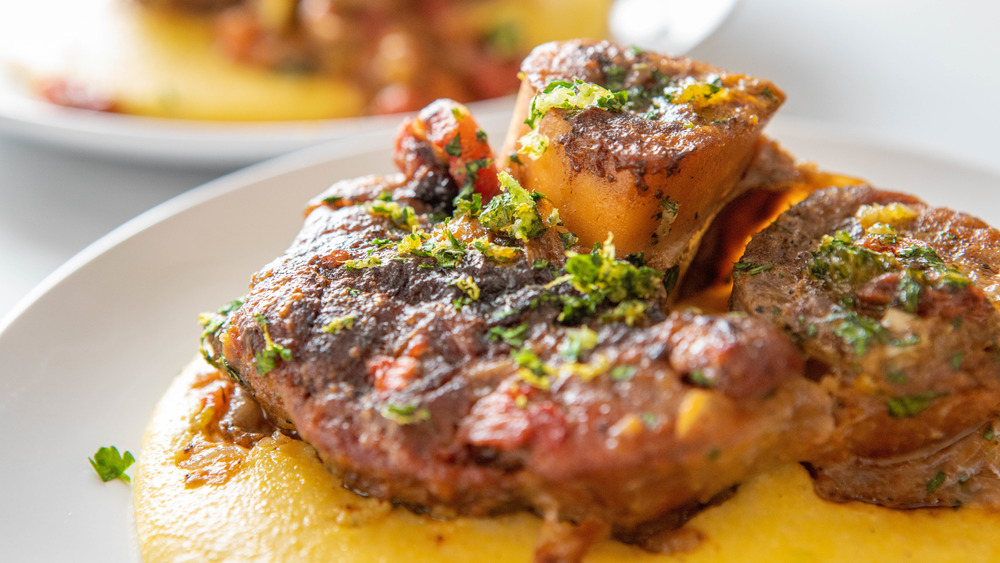
Ingredients
- 6 veal shanks
- 2 1/4 teaspoons kosher salt plus salt to taste
- 5/8 teaspoon black pepper plus pepper to taste
- 2 tablespoons unsalted butter
- 4 tablespoons extra-virgin olive oil
- 1/2 cup all-purpose flour
- 2 cups dry white wine
- 1 large onion
- 3 carrots, diced
- 2 celery ribs, diced
- 11 garlic cloves, pressed or minced
- 2 cups low-sodium chicken broth
- 2 small bay leaves
- 1 (28 ounce) can diced tomatoes
- 4 fresh thyme sprigs
- Zest of 2 lemons
- 1/2 cup fresh Italian parsley, minced (about 1 bunch)
Directions
- Pat the veal shanks dry with paper towels. Tie butcher's twine around each shank to keep the meat tight to the bone during braising.
- Season the shanks with 2 teaspoons of kosher salt and 1/2 teaspoon black pepper. Lightly coat the veal shanks in 1/2 cup of all-purpose flour.
- Heat a cast-iron Dutch oven or heavy-gauge pot on medium-high heat. Add 2 tablespoons extra-virgin olive oil.
- When the oil is shimmering, add 3 veal shanks. Sear them on each side for 5 minutes until golden brown. Transfer to a plate.
- Deglaze the pot with 1/2 cup white wine, scraping the brown bits from the bottom of the pot. Pour the liquid into a measuring cup and reserve.
- Add 2 tablespoons extra-virgin olive oil to the pot and sear the remaining 3 shanks. Transfer to a plate and deglaze the pot again with 1/2 cup white wine. Pour the liquid into the measuring cup.
- Melt 2 tablespoons unsalted butter in the Dutch oven or pot and add the diced onion, carrot, celery, 1/4 teaspoon kosher salt, and 1/8 teaspoon black pepper. Saute the vegetables until they begin to caramelize, about 8-10 minutes.
- Add 6 cloves of pressed or minced garlic and stir for 1 minute. Deglaze the pot with the remaining 1 cup white wine, then add the reserved reduced wine (from the measuring cup), 2 cups low-sodium chicken broth, 1 (28-ounce) can diced tomatoes, 4 fresh thyme sprigs, and 2 small bay leaves. Stir the braising liquid until combined.
- Heat the oven to 325 degrees Fahrenheit. Transfer the veal shanks to the pot, making sure they are submerged in the liquid. Put the lid on the pot and place it in the oven. Crack open the lid slightly to allow steam to escape. Braise for 2 hours or until fork-tender.
- For the gremolata: Combine the minced parsley, lemon zest, and 5 garlic cloves, minced in a bowl. Refrigerate until ready to serve.
- When the veal shanks are fork-tender, remove the pot from the oven. Sprinkle on 1/4 of the gremolata and stir gently. Let the ossobucco sit for 5 minutes in the braising liquid. Add salt and pepper to taste.
- Use tongs to carefully remove each veal shank from the pot. Carefully snip off the butcher's twine around each shank. For a thicker sauce, bring the braising liquid to a boil and let it reduce to the consistency you want.
- Serve each veal shank on a plate with polenta, risotto, or mashed potatoes. Ladle the braising liquid over the ossobuco and garnish with gremolata.
Nutrition
| Calories per Serving | 867 |
| Total Fat | 31.6 g |
| Saturated Fat | 9.3 g |
| Trans Fat | 0.2 g |
| Cholesterol | 385.2 mg |
| Total Carbohydrates | 28.0 g |
| Dietary Fiber | 6.4 g |
| Total Sugars | 7.6 g |
| Sodium | 2,148.1 mg |
| Protein | 101.5 g |
